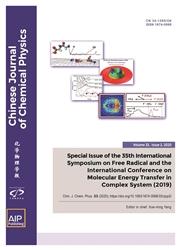缬氨酸生物合成酶机制的QM/MM研究
IF 1.2
4区 化学
Q4 PHYSICS, ATOMIC, MOLECULAR & CHEMICAL
引用次数: 0
摘要
紫荆素是植物中硫代葡萄糖苷(glucosinolates, GL)的主要和丰富类型,具有潜在的促进健康和抗虫功能。紫红素核心结构生物合成的最后一步在GL化合物中极具代表性,对应于硫转移酶(SOT)催化下从3-甲基硫丙基ds-GL到3-甲基硫丙基GL的过程。然而,由于缺乏SOT与3-甲基硫丙基GL络合的晶体结构,对这一磺化过程知之甚少。幸运的是,来自拟南芥(Arabidopsis thaliana)的sot18 (AtSOT18)含有类似于3-甲基硫丙基GL的物质(sinigrin)的晶体结构已经确定。为了了解其酶促机制,我们采用分子动力学(MD)模拟和量子力学结合分子力学(QM/MM)方法研究了AtSOT18催化ds- sinigin转化为sinigin的过程。计算结果表明,该反应是通过协同解离机制发生的。此外,Lys93、Thr96、Thr97、Tyr130、His155和两条酶肽链(Pro92-Lys93和Gln95-Thr96-Thr97)通过稳定过渡态几何结构来定位底物并促进催化反应。特别是在反应过程中,His155作为催化碱,Lys93作为催化酸。目前提出的一致解离机制解释了AtSOT18在紫红素生物合成中的作用,对其他SOTs催化GL生物合成的研究具有指导意义。本文章由计算机程序翻译,如有差异,请以英文原文为准。
QM/MM study on enzymatic mechanism in sinigrin biosynthesis
As the major and abundant type of glucosinolates (GL) in plants, sinigrin has potential functions in promoting health and insect defense. The final step in the biosynthesis of sinigrin core structure is highly representative in GL compounds, which corresponds to the process from 3-methylthiopropyl ds-GL to 3-methylthiopropyl GL catalyzed by sulfotransferase (SOT). However, due to the lack of the crystallographic structure of SOT complexed with the 3-methylthiopropyl GL, little is known about this sulfonation process. Fortunately, the crystal structure of SOT 18 from Arabidopsis thaliana (AtSOT18) containing the substance (sinigrin) similar to 3-methylthiopropyl GL has been determined. To understand the enzymatic mechanism, we employed molecular dynamics (MD) simulation and quantum mechanics combined with molecular mechanics (QM/MM) methods to study the conversion from ds-sinigrin to sinigrin catalyzed by AtSOT18. The calculated results demonstrate that the reaction occurs through a concerted dissociative mechanism. Moreover, Lys93, Thr96, Thr97, Tyr130, His155, and two enzyme peptide chains (Pro92-Lys93 and Gln95-Thr96-Thr97) play a role in positioning the substrates and promoting the catalytic reaction by stabilizing the transition state geometry. Particularly, His155 acts as a catalytic base while Lys93 acts as a catalytic acid in the reaction process. The presently proposed concerted dissociative mechanism explains the role of AtSOT18 in sinigrin biosynthesis, and could be instructive for the study of GL biosynthesis catalyzed by other SOTs.
求助全文
通过发布文献求助,成功后即可免费获取论文全文。
去求助
来源期刊

Chinese Journal of Chemical Physics
物理-物理:原子、分子和化学物理
CiteScore
1.90
自引率
10.00%
发文量
2763
审稿时长
3 months
期刊介绍:
Chinese Journal of Chemical Physics (CJCP) aims to bridge atomic and molecular level research in broad scope for disciplines in chemistry, physics, material science and life sciences, including the following:
Theoretical Methods, Algorithms, Statistical and Quantum Chemistry
Gas Phase Dynamics and Structure: Spectroscopy, Molecular Interactions, Scattering, Photochemistry
Condensed Phase Dynamics, Structure, and Thermodynamics: Spectroscopy, Reactions, and Relaxation Processes
Surfaces, Interfaces, Single Molecules, Materials and Nanosciences
Polymers, Biopolymers, and Complex Systems
Other related topics
 求助内容:
求助内容: 应助结果提醒方式:
应助结果提醒方式:


